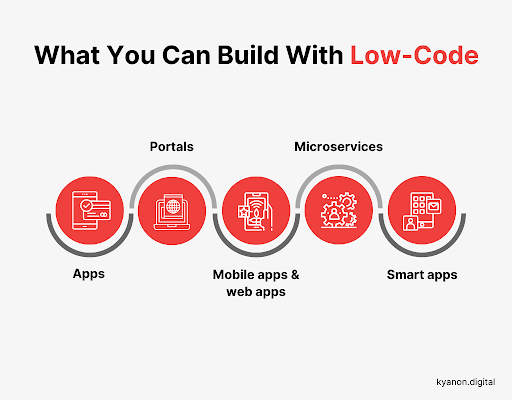Excellent News For Selecting Legacy application modernization with Low-code
Excellent News For Selecting Legacy application modernization with Low-code
Blog Article
Benefits Of Low-Code Application Development In Terms Of Integration Capabilities
Integration of low-code applications offers a variety of advantages, including the ability to seamlessly integrate different applications and systems. Here are the benefits of APIs and connectors that are pre-built:
Wide Variety of Connectors Low-code platforms typically come with an array of connectors that are pre-built for the most popular enterprise software (e.g. CRMs, databases, ERPs, cloud services). This allows for easier integration with systems.
API Integration: A lot of platforms provide out-of-the-box API integration features. This lets developers effortlessly connect with data from other sources and services.
Easy to Utilize:
Drag-and-Drop Interfaces: Several integration tasks can easily be performed using drag-and–drop interfaces. This makes it possible for developers and other non-developers to build complex systems without extensive coding.
Visual Workflow builders Visual Workflow Builders utilized to design workflows, data flow and integrations. They assist in understanding and setting up workflows more intuitively.
Standardized Integration Methods:
SOAP and RESTful Services Support for web service protocols like SOAP and REST allows easy integration with a variety of external systems and applications.
OData and various Standards Standards that support them like OData provides the easy access and manipulation of data on different platforms and applications.
Real-Time Data Synchronization:
Real-Time Integrations: Lowcode platforms can handle data synchronization in real-time between systems and applications making sure that data is updated and uniform across the organisation.
Event-Driven Architect: Some platforms have events-driven structures, allowing applications to respond immediately to events. This is important for dynamic interactive applications.
Legacy System Integration:
Low-code Platforms: These platforms could be utilized to connect legacy systems to modern systems. They're a great option to modernize your IT infrastructure, without having to redesign everything.
Data Migration: Built-in tools help transfer data from outdated applications to new ones built on platforms that have low-code.
Integration of Third-Party Services:
Cloud Services Integration: Easy scaling and deployment of apps is made possible by seamless integration with cloud services such as AWS, Azure and Google Cloud.
Business Applications Integration: Low-code platforms are able to be integrated with other business software like Salesforce, SAP and Microsoft Dynamics. This allows for a seamless workflow between the business functions.
Simplified Data Processing
Unified Data Models: Some low-code platforms have unification of data models which make it easier to manage the management of data and integrate across different systems.
Data Connectors: Data connectors that are pre-configured to provide easy access and manipulation of data derived from diverse sources.
Security and Compliance:
Low-code integration platforms comply with security standards that protect the data during transport or at rest.
Security Features: These platform typically have features that make sure that integrations comply with regulations, for example GDPR and HIPAA. This can provide peace ofmind for businesses handling sensitive information.
Extensibility:
Low-code platforms often meet complicated integration requirements by incorporating custom code or scripts. They offer flexibility without compromising the user-friendliness.
Plug-in Ecosystems. A community of plug-ins and extensions will allow you to further enhance the integration capabilities, and add new functionalities whenever needed.
In the end, the integration capabilities of low-code applications development platforms allow them to provide a robust platform for developing integrated and scalable, efficient and connected applications. They facilitate the process of connecting disparate systems, enhance the flow of data and enable businesses to adopt innovative technologies while also leveraging existing ones. Follow the recommended Low-code Platform for application development hints for more tips including cross platform app development, push notifications android, develop web app, build with docker, stored sql procedures, rapid app development, cloud software applications, ms azure sql, push notifications android, stored sql procedures and more.
Benefits Of Developing Applications Using Low-Code In Terms Of Cost-Effectiveness
Low-code applications offer a variety of advantages when it comes to cost-effectiveness. Businesses looking to optimize budgets can benefit from this method while still delivering high-quality applications. These are the main benefits: Reduced development costs:
Lower requirements for coding: Low code platforms eliminate the need for lengthy hand-coded, custom-built applications. Developers will spend less time and effort developing apps. This results in lower costs for labor.
Lower Developer Resources: As low-code is faster and simpler to create, less skilled developers will be required. This could drastically cut costs of staffing and hiring.
Speedier time to market:
Accelerated Cycle of Development: Low-code platform visual tools and components enable rapid development of applications, which lets businesses launch their products more quickly. This will result in increased revenue and boost your position in the marketplace.
Rapid Prototyping: Businesses are able to quickly create and test prototypes, which can cut down the time spent during the development process and allowing for faster iterations based on feedback from users.
Reduced Maintenance Costs
Simpler maintenance: Low-code platforms, with their modular design and components that are standardised can be maintained more easily. Maintenance and support cost is reduced.
Automated Updates Many low-code platforms are capable of managing patches and updates in a way that is both secure and timely. This eliminates the need to manually intervene.
Efficient Resource Utilization:
Contributions from Non-Developers Low-code platforms permit people who are not developers to participate in the process of development. This openness of development processes permits companies to tap into the expertise and expertise of a greater number of employees.
Improved utilization of IT resources IT departments get the chance to concentrate on more strategic projects, instead of getting bogged down with simple work tasks for development. Overall productivity and efficiency are improved.
Pricing models that can be scaled:
Subscription pricing: Many low-code platform offer flexible pricing plans for subscriptions that can be scaled according to usage. This lets businesses align their expenditure with their real needs and growth.
Pay-as-you-go options Certain platforms allow companies to pay for only the services they use. This is particularly useful for small or start-up businesses with a limited budget.
Lowering Third-Party Costs of Software:
Built-in Functionalities: Low-code platforms come with many built-in functions and integrations, which reduce the need for third-party tools and software. The cost of subscriptions and licensing charges are also reduced.
Pre-Built Integrations: The accessibility and pre-built integrations of popular applications and systems reduces the need for custom development and saves time and money.
Improved ROI
Improved ROI: Businesses can get a better ROI on applications that combine rapid development, lower costs and a faster times to market.
Enhanced Agility - Companies are able to swiftly adjust to changes in the market and changing customer needs. This lets them stay relevant and to take advantage of opportunities that come up.
Low-cost Training:
User-Friendly Interfaces: The simple interfaces and user-friendly features offered by low-code platforms reduce the learning curve, thus reducing the need to conduct extensive training.
Accessible Resources: Many low code platforms come with comprehensive instructional materials and tutorials along with community support. These resources reduce the requirement for formal instruction and the associated expenses.
Collaboration Streamlined:
Improved Collaboration Tool The built-in collaboration tool helps improve collaboration and communication between team members. This leads to better development processes and also reduces the cost of projects.
Unified Development Environment (UDE): An unified, single development environment streamlines processes and cuts cost and complexity that comes with managing various tools and platforms.
The efficiency of low-code application development is due to its ability to reduce development and maintainance expenses, speed up time to market, optimize resources, and also offer different pricing options. Low-code provides significant financial benefits for companies. View the best Legacy application modernization with Low-code advice for website recommendations including develop web app, rad development, app development platform, cross platform mobile app development, cross platform mobile app development, azure sql, microsoft azure sql, push notifications android, azure sql databases, paas service and more.
Benefits Of Low-Code Application Development In Terms Of Community Support And Vendor Support
Low-code platforms offer significant advantages both in terms of community involvement and vendor support and vendor support, both of which are essential for an effective implementation, maintenance and improvement of software. Here are a few major benefits: Support from vendors
Comprehensive Technical Support:
Dedicated Support Team: Many low-code platforms have a dedicated support personnel who are on hand to assist with technical issues in troubleshooting and guidance. They can make sure that problems are solved promptly.
Help is accessible 24/7: Many vendors provide around-the-clock assistance, which can be particularly useful for businesses that operate in different time zones.
Training and Onboarding
The structured training programs offered by vendors provide structured courses such as webinars or courses for certification. This helps users quickly grasp the platform.
Personalized Onboarding: Many vendors offer personalized onboarding to assist new customers to use the platform efficiently and adapt it to meet their requirements.
Regular Updates, Enhancements and Enhancements:
Continuous improvement: Low-code platform providers generally release periodic updates which include new features, performance improvements and security patches ensuring that the platform stays cutting-edge and safe.
Feedback Integration: Vendors include feedback from their users into their design cycles to ensure the platform is constantly evolving to meet the evolving needs of their users.
Comprehensive Documentation:
Documentation is thorough: Users are usually able to access a large and well-organized documents, ranging in complexity from simple modification to advanced.
API References API documentation contains complete API references to assist developers connect their low-code platform apps with other platforms.
Consulting and Professional Services
Expert Consulting: A lot of vendors offer consulting services that help users with complex design and implementation and also strategic planning.
Custom Development: Some vendors provide services that permit them to create specific features or the features, but they aren't available from the beginning.
Community Support
Active User Community:
Discussion boards and forums Forums and Discussion boards: Many low-code platforms provide active online communities for users to exchange ideas, ask questions, and collaborate.
Local and virtual User Groups as well as Meetups, offer opportunities for users to discuss their experiences, learn from other users, and connect with.
Knowledge Sharing and Collaboration
Community-Contributed Resources: Users often share templates, modules, and extensions that they have developed, which can be reused or adapted by others, accelerating development and innovation.
Crowdsourced Problem-Solving: The collective expertise and experience of a group can be an extremely valuable source to solve problems and find creative solutions for difficult problems.
Learning and Development
Community-led training A lot of community groups offer training sessions, webinars, and workshops led by experts who are experienced in the field.
Online Tutorials and Courses The community members develop and share tutorials, online courses and how-to guides. This improves the learning tools that are accessible to the users.
Feedback and Influence
Product Feedback: Many community forums allow users to provide feedback to manufacturers. This could influence the development of new features and improvements.
Beta Testing Programs: Active community members may have the opportunity to take part in beta testing programs, giving them early access to new features as well as a say in shaping the platform's evolution.
Recognition and Encouragement
Community Recognition Programs - Many vendors have recognition programs that recognize the contribution of active members of their communities and include MVP (Most Valuable Professionals) programs.
Peer Support. Community members offer peer support. They share their knowledge with less experienced users and offer guidance. This creates an atmosphere that is supportive and collaborative.
Overall the combination of strong vendor support and an active connected community offers a comprehensive support ecosystem for the development of low-code applications. This ensures that users have access to the resources as well as the expertise and collaboration opportunities required to effectively create, deploy, and maintain their apps improving the efficiency and effectiveness of their applications.